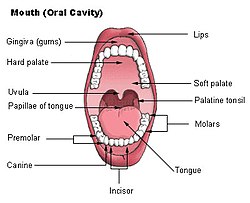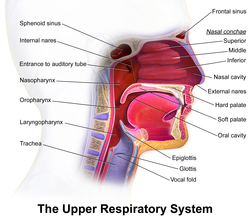Hard palate
This article needs additional citations for verification. (September 2014) |
| Hard palate | |
|---|---|
 Mouth (oral cavity) | |
 Upper respiratory system, with hard palate labeled at right | |
| Details | |
| Artery | Greater palatine artery |
| Nerve | Greater palatine nerve, nasopalatine nerve |
| Identifiers | |
| Latin | palatum durum |
| MeSH | D021362 |
| TA98 | A05.1.01.103 |
| TA2 | 2779 |
| FMA | 55023 |
| Anatomical terminology | |
The hard palate is a thin horizontal
Structure
The hard palate is formed by the
On the ventral surface of hard palate, some projections or transverse ridges are present which are called as palatine rugae.[1]
Function
The hard palate is important for feeding and speech. Mammals with a
Clinical significance
Cleft palate
In the
While a cleft palate has a severe impact upon the ability to nurse and speak, it is now successfully treated through reconstructive surgical procedures at an early age. This is the time where such procedures are available.
Due to the complexity of this birth defect, researchers still do not know exactly what causes the cleft palate to form during foetal development. Recently, these researchers found that even though there is no exact cause, there are several factors that drastically increase the risk of a baby being born with an orofacial cleft palate. As for the environmental risk factors, maternal smoking is the most influential risk factor. Based on a recent study of 103 German patients with cleft palates, it was found that 25.2% of their mothers smoked during pregnancy, a higher proportion than for the population as a whole.[2]
While maternal smoking during pregnancy is a risk, there are also several genetic risk factors. Six
Palatal abscess
Palatal abscesses may also occur.[5]
Hard palate pigmentation
Long-term use of the drug chloroquine diphosphatase, used in malaria prophylaxis, rheumatoid arthritis and other conditions, was found to cause bluish-grey pigmentation in the hard palate.[6][7]
See also
- Electropalatograph
- Head and neck anatomy
- Maxilla
- Palate
- Soft palate
